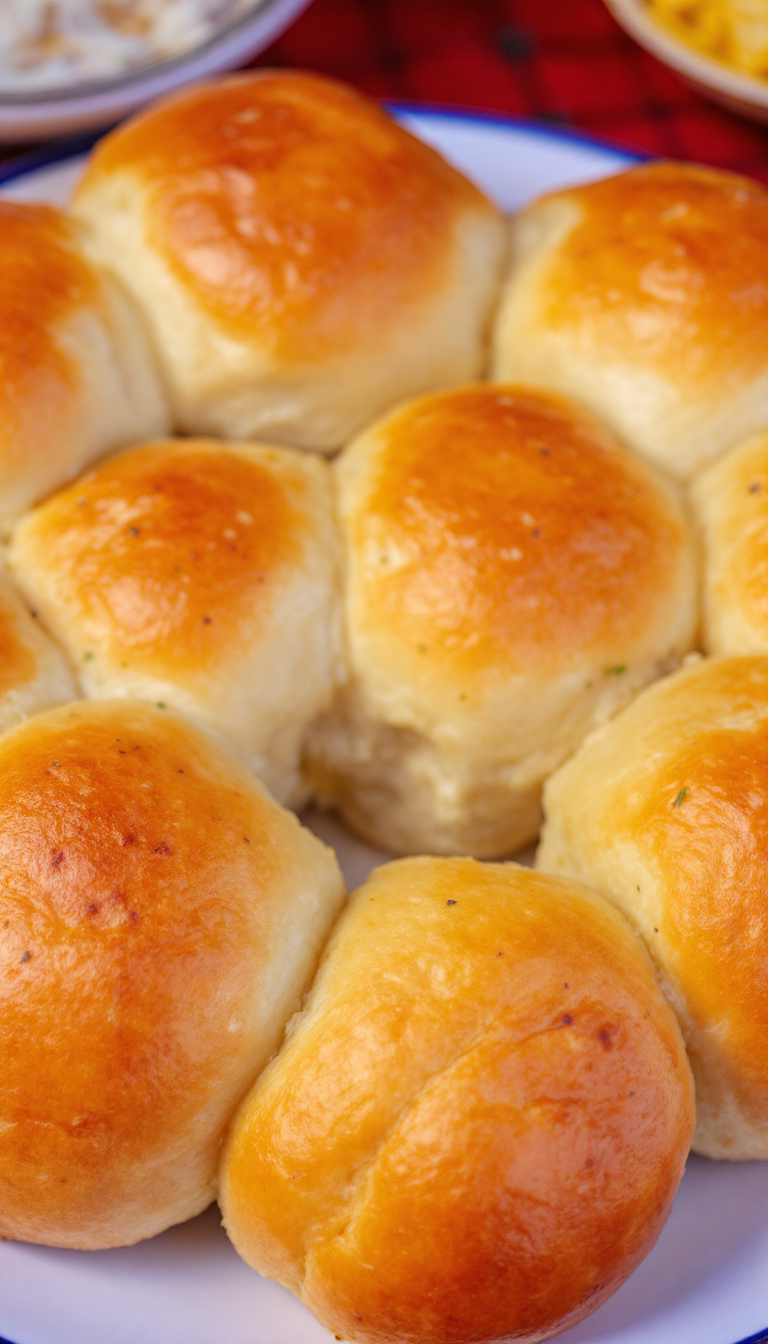Ah, dinner rolls—those soft, pillowy delights that can make any meal feel like a warm hug. It’s funny how a simple roll can bring back memories of family dinners, isn’t it?
I remember the first time I tried baking them myself; I was both excited and terrified. The kitchen was a mess, flour everywhere, but the aroma—oh, the aroma—was absolutely worth it.
And you know, in today’s hustle and bustle, sometimes it’s nice to just slow down and savor the process of making something with your own hands. These rolls are like little clouds of joy that everyone will reach for, and with good reason.
They’re perfect for mopping up gravy or just slathering with a pat of butter. So, grab your apron and let’s get rolling!
Steps
- In a small bowl, mix warm milk and sugar, then sprinkle the yeast on top. Allow it to sit for about five minutes until it becomes foamy.
- Pour the yeast mixture into a large mixing bowl and add softened butter, egg, salt, and two cups of flour. Mix on medium speed until the batter is smooth.
- Gradually add more flour to the mixture until a soft ball of dough forms. Increase the mixer speed to medium-high and knead for 2-3 minutes, ensuring the dough is tacky but not sticky. If needed, incorporate more flour a tablespoon at a time.
- Grease a large bowl lightly and place the dough in it, turning once to coat. Cover with a dish towel and let it rise in a warm spot until the size doubles, approximately 45-60 minutes.
- Gently punch down the dough, then roll it out on a floured surface into a 12×8 inch rectangle, ½ inch thick. Cut into 24-30 even pieces.
- Arrange the dough pieces on prepared baking sheets, cover with a dish towel, and let rise in a warm place until nearly doubled, about 45-60 minutes. Preheat the oven to 350 degrees Fahrenheit during the last 20 minutes of rising.
- Bake the rolls in the preheated oven for 12-15 minutes until they turn golden brown. Once out of the oven, brush them with melted butter and serve warm.
Ingredients
- 1 packet active dry yeast
- 1 ¼ cups warm milk (approximately 105-110 degrees Fahrenheit)
- ? cup granulated sugar
- ¼ cup unsalted butter, at room temperature (equivalent to ½ stick)
- 1 large egg, at room temperature
- 1 teaspoon kosher salt
- 3 ½ to 4 cups all-purpose flour, plus additional for kneading
- 3 tablespoons unsalted butter, melted
Nutritional Values
Calories: 7800kcal | Carbohydrates: 1464g | Protein: 216g | Fat: 120g | Saturated Fat: 72g | Trans Fat: N/A | Cholesterol: 408mg | Sodium: 2568mg | Potassium: 2568mg | Fiber: 48g | Sugar: 96g | Vitamin A: 3240IU | Vitamin C: 24mg | Calcium: 648mg | Iron: 72mg
FAQ
- Why didn’t my dough rise?
- This could be due to expired yeast or improper milk temperature. If the yeast doesn’t froth during activation, it may be ineffective. Additionally, if the room is cold, the dough may require more time to rise.
- Can I use instant yeast instead of active dry yeast?
- Yes, instant yeast can be used, as it does not require proofing. Simply add it to the other ingredients. However, all other ingredients should remain the same.
- How do I store leftover Texas Roadhouse rolls?
- At room temperature, rolls can be wrapped in foil or plastic wrap for up to 5 days. For longer storage, freeze them for up to 6 months, and thaw them at room temperature when ready to eat.
- What should I do if the dough hasn’t doubled in size after an hour?
- If the dough hasn’t risen, leave it longer until it doubles, especially if the room is cooler. Alternatively, move it to a warmer spot to expedite the process.
- Is it possible to freeze the rolls?
- While they taste best fresh, you can freeze them. Store them in a freezer container and thaw before serving.
Tips
- Make sure your milk is between 105 to 110 degrees Fahrenheit when activating the yeast. If it’s too hot, it can kill the yeast, and if it’s too cold, the yeast may not activate properly.
- For even baking, cut the dough into uniform squares. While exact measurements aren’t necessary, try to make the pieces approximately the same size for consistent results.
- If your dough isn’t rising, check the yeast’s expiration date and ensure your environment is warm enough. A cold room can slow the rising process, so consider moving the dough to a warmer spot or preheating your oven to 200 degrees Fahrenheit, turning it off, and placing the dough inside with the door closed.
- To store leftover rolls, wrap them in foil or plastic wrap and keep them at room temperature for up to five days. Alternatively, you can freeze them for up to six months and thaw them at room temperature when ready to eat.
Equipment
- Stand mixer with a dough hook attachment – This is important for kneading the dough efficiently.
- Silicone baking mat – Useful for preparing the baking sheets to prevent sticking.
- Cooking thermometer – To ensure the milk is heated to the correct temperature for activating the yeast.


